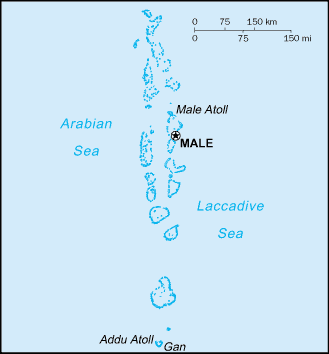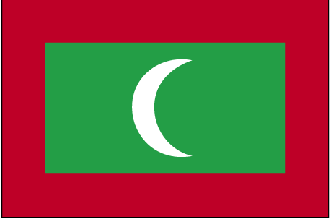
|
Maldives
Background:
The Maldives were long a sultanate, first under Dutch and then under British
protection. They became a republic in 1968, three years after independence.
Tourism and fishing are being developed on the archipelago.
Location:
Location: Southern Asia, group of atolls in the Indian Ocean, south-southwest
of India.
Area: total: 300 sq km.
Area - comparative: About 1.7 times the size of Washington, DC.
Coastline: 644 km.
Climate and Terrain:
Climate: Tropical; hot, humid; dry, northeast monsoon (November to March);
rainy, southwest monsoon (June to August).
Terrain: Flat, with white sandy beaches.
Elevation extremes: Lowest point: Indian Ocean 0 m, highest point: unnamed
location on Wilingili island in the Addu Atoll 2.4 m.
Natural resources: Fish.
Irrigated land: NA sq km
Geography - note: 1,190 coral islands grouped into 26 atolls (200 inhabited
islands, plus 80 islands with tourist resorts); archipelago with strategic
location astride and along major sea lanes in Indian Ocean.
People:
Population: 329,684.
Ethnic groups: South Indians, Sinhalese, Arabs.
Religions: Sunni Muslim.
Languages: Maldivian Dhivehi (dialect of Sinhala, script derived from Arabic),
English spoken by most government officials.
Government:
Government type: Republic.
Capital: Male.
Independence: 26 July 1965 (from UK.)
Economy overview:
Tourism, Maldives largest industry, accounts for 20% of GDP and more than 60%
of the Maldives' foreign exchange receipts. Over 90% of government tax revenue
comes from import duties and tourism-related taxes. Almost 400,000 tourists
visited the islands in 1998. Fishing is a second leading sector. The Maldivian
Government began an economic reform program in 1989 initially by lifting import
quotas and opening some exports to the private sector. Subsequently, it has
liberalized regulations to allow more foreign investment. Agriculture and
manufacturing continue to play a lesser role in the economy, constrained by the
limited availability of cultivable land and the shortage of domestic labor.
Most staple foods must be imported. Industry, which consists mainly of garment
production, boat building, and handicrafts, accounts for about 18% of GDP.
Maldivian authorities worry about the impact of erosion and possible global
warming on their low-lying country; 80% of the area is one meter or less above
sea level.
Statistics:
Telephones - main lines in use: 21,000.
Telephones - mobile cellular: 1,290.
Radio broadcast stations: AM 1, FM 1, shortwave 1.
Radios: 35,000.
Television broadcast stations: 1.
Televisions: 10,000.
Internet users: 6,000.
Airports - with paved runways: 2, with unpaved runways: 3.
Return to Visiting Locations
|

